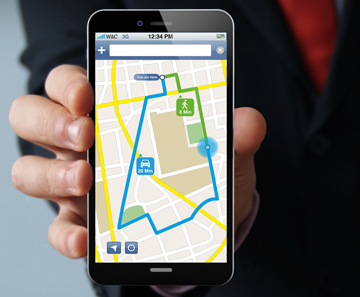BY MADELEINE MACCAR
It’s no secret that corporate travel, once the seemingly untouchable golden ring positioned just beyond the reach of TNCs’ on-demand services, is now contested territory. Any transportation professional knows that a casual driver who’s been picking up digital hitchhikers for 12 hours in a poorly maintained two-door jalopy just to make some extra cash can’t compare to the well-trained and immaculate chauffeurs who are so sought after in our industry for their expertise in handling VIP clients and high-end vehicles. That, however doesn’t seem to be stopping corporate clients from hopping into an Uber or Lyft car these days, especially since both have begun offering so-called luxury divisions—presumably part of especially Uber’s aggressive attack on wooing Fortune 1000 companies. Global Business Travel Association (GBTA) projects that global travel spending will reach $1.6 trillion by 2020 (now estimated at $1.3 trillion for 2016, up from 2015’s $1.2 trillion), so it’s likely too tempting for them to ignore. With both companies and the rest of their ilk proving to be as adept at downplaying the true cost of surge-pricing as they are at winning favor with the public while eschewing regulations—or outright dismantling them at a legislative level—it shouldn’t be a surprise that corporate America is just as susceptible to new trends and discount services (if not in price then unquestionably in quality) as the rest of the riding public.
 But there will always be those corporate travelers who prefer the service of a professional chauffeur and the guaranteed amenities that come with booking a luxury ground transportation vehicle—not to mention, of course, the peace of mind that comes with being in the care of a trustworthy operation bound by duty of care and the safety regulations guiding its industry.
But there will always be those corporate travelers who prefer the service of a professional chauffeur and the guaranteed amenities that come with booking a luxury ground transportation vehicle—not to mention, of course, the peace of mind that comes with being in the care of a trustworthy operation bound by duty of care and the safety regulations guiding its industry.
Some corporate travelers who gravitated to the convenience of TNCs will come to realize the true worth of your services and once again rely on them; some diehard black car users will eventually be swayed by the siren call of shiny new technologies. Through it all, the trends that punctuate the corporate travel sector will run the gamut of adapting to changing tastes and simply falling by the wayside as newer, potentially better ways of doing business emerge. As the second half of 2016 picks up steam, it’s evident that TNCs will continue to influence corporate America—but they certainly don’t have the monopoly on rising trends and steadfast mainstays.
We’ve done our research and listened to the experts to bring you five corporate travel trends that seem to be among 2016’s most prevailing ones so far.
 1. Investing in Technology
1. Investing in Technology
Passengers have spoken loud and clear: An app’s nifty baubles that streamline business transactions, provide constant updates, and pass along a sense of autonomy to the passenger are here to stay. Is it any wonder that your pressed-for-time corporate clients just want to know that their car is getting ever closer or exert their own level of control over the updates assuring them their tight schedule isn’t in danger of coming spectacularly undone?
It is, of course, far easier (not to mention less expensive) to acknowledge that we need to keep stepping up our gadget game than to actually deliver on those costly, disruptive updates, with the industry utilizing an array of technologies that aren’t always up to modern times’ demands—or even compatible with each other. But we do have the advantage of options, thanks to numerous technology providers catering to our industry who are aware of the problems we need to tackle before falling even farther behind in a gizmo-obsessed world. A number of systems are offering packages that bring your back-office systems into the 21st-century world where demands of real-time viewing and service at breakneck speeds are king, while also delivering apps that rival TNCs’.
According to Travel Market Report, mobile and big data are two sectors where 2016’s most significant investments are heading, which means that everyone is upping the technological ante this year. You can have the newest high-end fleet, the most professional chauffeurs, and the best on-time track record around—but woe to the operator who gets between a corporate traveler and the effectiveness of his mobile office by not offering the same technology he’s increasingly receiving from the thoroughly modern office buildings, hotels, and even restaurants he’s also patronizing between his drop-off and pickup times.
2. Focus on Group Work
Sure, anyone with a driver’s license can whip around a centralized location to move his passenger from point A to point B, but how many TNC drivers are operating CDL-exclusive or specialty vehicles? As long as there’s a barrier to entry that keeps underqualified drivers from tackling high-occupancy vehicles, group work will continue to be a boon to our industry.
Make the most of your access to motorcoaches, executive vans, buses, and other big-group-friendly vehicles by branching out and getting creative with the metal that the general public doesn’t have access to. Have a corporate outing during the week when your most impressive retail vehicles are sitting in the garage? See if your passengers want to be driven in something less traditional than a SUV.
Business travel has become an integral part of conducting business and as such needs to be considered in duty of care with health and safety policies.” – GBTA’s Corporate Social Responsibility Toolkit.
It will always be preferable to move a group together rather than in a roving herd of mismatched TNC cars, so capitalize on the opportunity for teambuilding and networking on the road since you’re already accustomed to your vehicles serving as your passengers’ de-facto offices. Meetings and roadshows are certainly still a considerable source of corporate work, and helping your most focused business passengers get ahead of the game while making the most of their travel time will go a long way to ensure their loyalty.
Additionally, we all know that the ever-changing nature of group work requires a flurry of updates and constant contact with a transportation provider to ensure that significant details like passenger counts, pickup locations, and drop-off times are confirmed and as current as the reality of fluid plans dictates. TNCs’ lack of both a number to call and immediately accessible customer-service representatives will continue to be a deterrent for the travel managers whose job it is to stay on top of transportation logistics—and whose concerns are easily allayed by speaking to the kind of knowledgeable, calming human voices that so many operators know to include among their core teams.
3. Widening Your Global Scope
As the world gets smaller and smaller through mergers and acquisitions, constant connectivity, and an increasingly scrutinized examination of the ripple effects of worldwide commerce, your company will need to keep pace with an uptick in corporate globetrotters.
Of course, TNCs are a worldwide menace, but how many international travelers would prefer to simply have a ride already waiting for them as soon as they set foot on foreign soil after what was a most assuredly long haul of a flight? Help your far-flung corporate clients answer their most pressing questions about foreign transportation to make the best impression: Is a larger network the way to go? Would they rather you arrange the trip or just provide a list of suggested travel partners at their destination? Are the transaction processes and service levels comparable to what they’re used to at home, and should they be prepared for any surprises? Go that extra mile to minimize potential roadblocks for a corporate client headed overseas.
If you’re not already a global brand, make it a priority now. International expansion obviously isn’t a reality for most companies—but widening your global affiliate network surely is. Talk to your industry peers, make a few new connections based on recommendations for trustworthy operators in other countries, and don’t forget to stop by the Affiliate Central Global Partner Forum at our upcoming show in Washington, D.C., this October! Having world-class international recommendations at the ready is sure to win you points among your corporate travelers without borders.
4. Increased Focus on Duty of Care
Both a rallying cry against TNCs’ historically more negligent (if not outright hostile) approach to transporting human cargo and one of the definitive advantages of riding with our industry’s operators, duty of care is not just in the chauffeur’s and your company’s hands anymore. These days, a passenger’s travel manager even has to be aware of the liability issues that arise from putting a company big-wig on the road as risk management becomes a hot-button issue for more and more corporate customers and their companies.
“The social and ethical dimension of responsible travel management goes beyond sustainable procurement,” according to the GBTA’s Corporate Social Responsibility Toolkit. “Business travel has become an integral part of conducting business and as such needs to be considered in duty of care with health and safety policies.”
More business travel means more business travelers, and more business travelers means more passengers in your care, as your employee and your vehicle are still responsible for safely ferrying your corporate traveler to her destinations. Working with travel managers to understand everyone’s degree of responsibility will be to your benefit, and this is the perfect opportunity to stress that working with your company rather than a TNC seems a bit pricier—even so, can you put a dollar amount on the safety of another human being?
Lenore D’Anzieri of Limo Alliance and a longtime corporate travel expert offers the following insight: “The first and most important things I’ve seen in terms of these corporations are safety and security. How do you help them find a happy medium among pricing, safety and security, and convenience? Corporate travel managers are looking for a solution as they become more aware of the risks their travelers take in accepting a ride from a less-regulated ground transportation option.”
5. Minimizing TNC-Related Leakage
Even with the ever-blackening eyes of TNCs, we know that once the public falls in love with a perceived perfect marriage of cost effectiveness and convenience, it’s hard to shake those passengers from their honeymoon reverie. But your corporate accounts are most likely to be swayed back from the dark side once you can prove to them that you’re worth the cost—which, again, is really more illusory than less vigilant observers of TNCs’ underhanded tactics realize.
“Travel managers and procurement departments are trying to manage the leakage in their travel policies from people using TNCs,” D’Anzieri says. “That leakage they’re experiencing is a lot for them to get a grip on, and what is specifically plaguing them is figuring out what they need to do to control that spend—and also protect the travelers who insists on taking TNC vehicles.”
You know how important the bottom line is, and how seemingly small expenses can accumulate into significant deficits in no time at all: Seize this opportunity to humanize your company and get on your client’s level. Outrageous travel spend is one thing; wasting money while also putting a corporate traveler at risk is another. Present them with the numbers, factoring in surge pricing’s additional bite out of a company’s travel budget, to empirically prove that putting their own VIPs in your cars is the only way to ensure their safety without bleeding money.
Now more than ever, the industry—just like the world around it—is changing at speeds no one could have ever anticipated years ago, and staying on top of trends will keep you in the know and ahead of the curve all the way to the bank. [CD0716]

